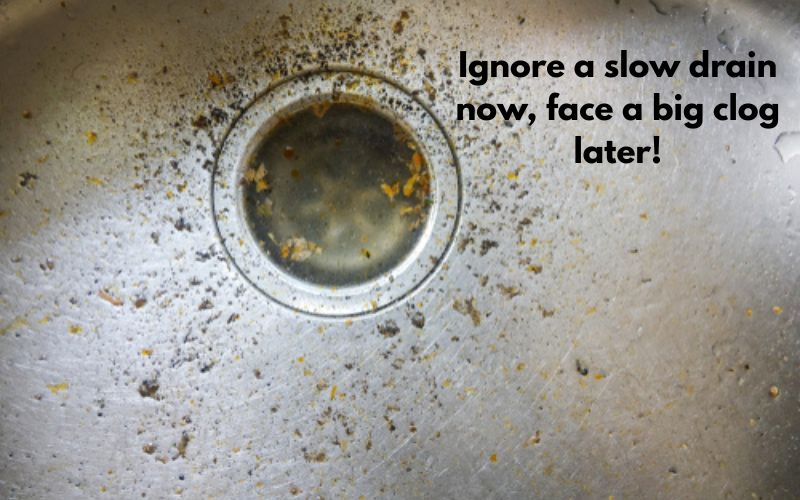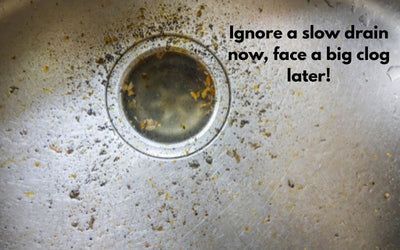What Happens If I Ignore a Slow Drain for Months?

You've probably been pushing aside that slow drain for weeks, assuming it's soap scum or hair. You're not alone. Here's the reality, though: a drain that remains slow for more than a month is never benign. It's usually the earliest indication that waste isn't flowing the way it should, and pressure is building stealthily in the background.
A slow drain is not only a hassle. If left unchecked, it can escalate into clogs that propagate through your pipes, overwork your septic system—especially if regular septic tank cleaning hasn’t been done—or even create backflow into your house. Addressing it early helps unclog drains before they turn into costly plumbing or septic issues.
So how do you know if your “small delay” is turning into a bigger failure? Let’s look at the warning signs you can spot early.
Warning signs of slow drains for months
If your drain has been dragging for months, don’t wait for the flood, it’s already giving you clues. Some are obvious, others easy to miss. Here’s what to look for.
Progressive Clogging
A drain that slows down month after month isn’t just “sluggish.” It’s the start of a clog that grows silently. What begins with grease or hair sticking inside the pipe soon traps food bits, soap, and other solids. Over time, the buildup spreads beyond one sink or shower and affects the entire line.
What you’ll notice:
- Water takes longer to clear every week.
- More than one sink or drain showing the same delay.
- Occasional standing water that doesn’t fully empty.
Ignoring these early hints means the blockage will keep spreading, until you’re dealing with backups in multiple fixtures, not just one.
Air Pockets and Gurgling
When you hear gurgling or bubbling after a flush or while another tap is running, it means air is trapped in the line. That happens when water flow is blocked or slowed, creating pockets of pressure that release as noise.
What you’ll notice:
- Gurgling from a sink when you flush the toilet.
- Bubbling sounds in the shower drain.
- Popping noises in pipes after water use.
These aren’t “quirky sounds”, they’re early warnings that your pipes aren’t breathing properly. Left alone, they can escalate to full blockages or venting failures.
Surging Pressure in Septic Tanks and Soakaways
When drains slow down for months, pressure doesn’t just build in the pipes—it also affects your plastic septic tank or soakaway system. That pressure forces liquid where it doesn’t belong, damaging the setup.
What you’ll notice:
- Water pooling around the tank or soakaway area.
- Toilets flushing sluggishly, even after plunging.
- Occasional backflow into lower-level drains.
These are signs the system is under strain. If ignored, it can end with effluent surfacing or leaking underground.
Micro-Leaks and Soil Saturation
Slow drains create pressure points that force tiny leaks at pipe joints or cracks. At first, you won’t see them, but the soil around the line starts absorbing moisture.
What you’ll notice:
- Damp patches or unusually green strips in the yard.
- Soft or sunken ground over buried lines.
- Musty smell near walls or flooring.
These small leaks rarely stay small. Once the soil is saturated, the damage spreads to foundations and groundwater.
How Neglected Slow Drains Escalate to System Failure
From clogs that spread to pipes that crack, septic tanks that overflow, and even backflow into your home, here’s how one delay sets off a bigger failure.
Blockage Propagation
A slow drain doesn’t just stay slow. Over time, solids like hair, grease, and soap scum start to build up more and more. The blockage grows, water flows harder, and pressure inside the pipe increases. Eventually, the clog spreads to other connected drains. What started in the kitchen might soon affect the bathroom or laundry sink.
Recent Times of India reports show this is common: small blockages in homes often expand, causing repeated backups in multiple fixtures. Ignoring a slow drain can turn one minor issue into several problems that need professional attention.
Structural Damage to Pipes and Joints
When a drain stays slow for months, water doesn’t just sit in the pipe, it puts extra pressure on the joints and pipe walls. Over time, this can cause old PVC or cast iron pipes to crack or corrode, and joints can start to separate. At this point, the problem isn’t just a clog anymore. You may need to replace sections of pipe, which can be much more expensive and disruptive than simply clearing the drain.
Local reporting, such as on Gurgaon’s aging pump stations, shows how overloaded systems fail mechanically over time. The same principle applies at home: sustained pressure and water buildup can damage your pipes before you even notice a major leak.
Septic Tank Overload and Effluent Escape
When a septic tank can’t settle or drain properly, it starts pushing out partially treated wastewater. This effluent can surface in your yard, seep into the soil, or saturate your soakaway so it stops absorbing water effectively.
- Research from PLOS shows that failing septic systems can release pathogens into the surrounding environment, creating a real health risk.
- Local studies, like the Wai desludging study, also highlight that regular septic tank cleaning prevents overflow and keeps the system functioning properly. Ignoring a slow drain for months can quietly put your plastic septic tank under stress until effluent starts escaping.
Backflow and Network Impact
A slow or failing drain in your home doesn’t just affect that one fixture. It can create pressure imbalances that push wastewater back into other sinks, toilets, or shared sewer lines. In areas with congested drainage networks, this can even contribute to street-level overflows.
A recent report from Noida, Greater Noida, and Gurgaon illustrates how a minor clog or pump malfunction at one location can cause backups in several houses or avenues. At home, this translates to a forgotten slow drain causing larger issues than you think without making a sound.
It’s Time to Act Before It Gets Worse
Easy measures you can take right now:
- Perform the 60-second sink test: fill and drain. If it slows down, take action.
- Take note of recurring problems, twice a month or more, that is escalation.
- Check outside spaces after periods of dry weather: for soggy or soft ground.
- For gurgling sounds when other fixtures are being used.
- If you catch slow drains early, apply Bioclean septic tank cleaning powder, its enzyme content dissolves waste naturally and rejuvenates free flow.
Most Band-Aids only move the issue down the road. Bioclean does things differently: it puts live enzymes that break down grease, hair, and organic material in your drains and septic tank to unclog drains naturally. That means clogs don't just migrate — they dissolve. For homes struggling with slow drains, it's the easiest preventative measure before expensive repairs, septic overflow, or structural damage become issues.




